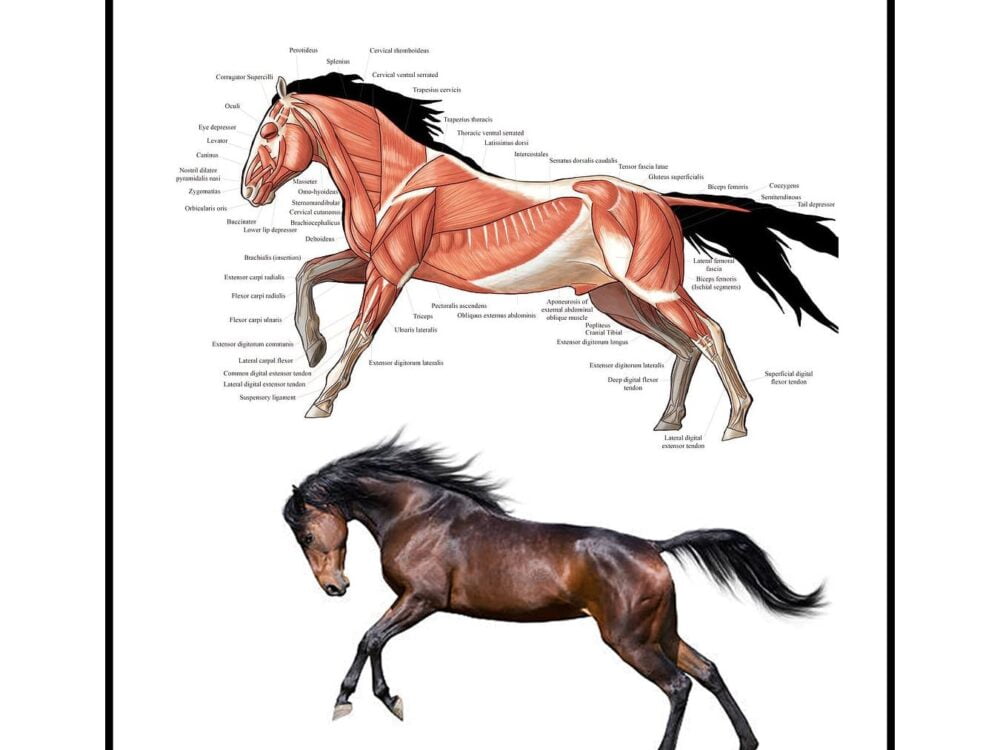
What Are The Signs Of Tying Up?
What Are The Types Of Tying Up?
What Triggers Tying Up In Horses?
How To Help Prevent Tying-Up?
The term tying-up is used to describe a wide variety of muscle disorders that can occur in performance horses.
The scientific name is Rhabdomyolysis, where the ‘myolysis’ part means muscle breakdown.
Clinical signs of tying up are varied and depend on the severity of the episode.
WHAT ARE THE SIGNS OF TYING UP?
Uncontrolled contraction of muscle groups and reluctance to move are the main signs. The muscles in the hindquarters commonly most affected.
Other signs:
- Pain and sensitivity
- Increased heart & respiratory rate
- Profuse sweating
- Temperature up to 40°C
- Gait gradually stiffens/locks
- A tying-up episode can persist for several hours and in severe cases, the horse’s urine turns a dark, red-brown colour which is due to the broken down muscle protein called myoglobin.
- When muscle cells are damaged, they release high amounts of certain enzymes into the blood circulation. They are Creatine Kinase (CK) and Aspartate Aminotransferase (AST) and both show up in high levels on blood testing profile.
- The peak levels for CK occur 4-6 hours after an episode of tying-up.
The cause of tying-up centres around muscle management, biochemistry and physiology. It is not known which single mechanism triggers the condition but the combination of many factors are known to contribute to the severity.
WHAT ARE THE TYPES OF TYING UP?
- Recurrent Exertional Rhabdomyolysis (RER) – occurs when calcium is trapped inside the muscle cells preventing them from fully relaxing.
Prolonged partial contraction leads to muscle damage and considerable pain. - Polysaccharide Storage Myopathy (PSSM) – is the accumulation of glycogen in the muscle tissue, but the structure of the glycogen is not normal, due to a genetics and this is where the issue occurs. When the horse is exercising, it needs to access this glycogen for energy and the abnormal glycogen structure prevents this from happening.
When looking at equine muscle physiology and more importantly the need for muscles to be worked and fuelled appropriately, asking a horse to perform beyond their fitness level will increase the risk of tying up.
WHAT TRIGGERS TYING UP IN HORSES?
Excessive muscle breakdown is a side effect of overtraining an under conditioned muscle. Unrealistic workloads along with electrolyte imbalances (particularly low sodium), vitamin E/selenium deficiencies or a concurrent illness (virus) all can provide triggers for tying-up.
The many other possible triggers include:
- Calcium: Phosphate ratio imbalance
- Dehydration
- Hypotension / Nervousness
- Inadequate oxygen transport to muscles
- Abnormal carbohydrate metabolism
- Lactic acid build-up
- Hormone imbalances
- Genetic inheritance
- Oats – There is only anecdotal evidence and no scientific reason/evidence to why oats trigger a tying up episode. It is unclear exactly why, as their nutritional profile is very healthy with 80%-90% digested by the small intestine. This is a huge advantage over other grains because if too much starch gets into the large intestine, it affects the microbiome environment and surrounding tissue leading to many health issues.
HOW TO HELP PREVENT TYING-UP?
Limit the risk of tying-up by focusing on good dietary and exercise management.
Keep to a consistent exercise schedule within your horse’s fitness level, building fitness levels up so they are handling the work before increasing the workload.
The majority of their diet should be based around fibre (pasture or grassy hay) and keep grain intake to a minimal unless an increase in calories is required due to the workload.
Provide a quality plant-based Omega 3 oil as a healthy cool source of calories, which does not contribute to the lactic acid levels.
Meeting all essential daily vitamin and mineral requirements including those for electrolytes and antioxidants will also help limit the risk of your horse of tying up.
Especially:
- Calcium, Phosphate, Magnesium
- Antioxidants – Vitamin E & Selenium
- Electrolytes – Sodium, Potassium & Chloride
Please contact us if you would like us to help balance the nutrient profile of your horse’s diet.
Written by Bryan Meggitt (BMedSc. PGCrtMedSc.)
Biochemist / Senior Scientist and Co-founder of CEN Horse Nutrition
Bryan is passionate about improving equine health through nutrition according to science & nature.

